Practical N-Hydroxyphthalimide-Mediated Oxidation of Sulfonamides to N-Sulfonylimines
Abstract
1. Introduction
2. Results and Discussion
3. Experimental Sections
3.1. General
3.2. Experimental Method
3.2.1. General Procedure for NHPI-Mediated Oxidation of Sulfon-amides to N-Sulfonylimines
3.2.2. Procedure for Gram-Scale reaction
3.3. Characterization Data of New Compounds
4. Conclusions
Supplementary Materials
Author Contributions
Funding
Acknowledgments
Conflicts of Interest
References
- Tansakul, C.; Braslau, R. Nitroxides in Synthetic Radical Chemistry. In Encyclopedia of Radicals in Chemistry, Biology and Materials; Chatgilialoglu, C., Studer, A., Eds.; John Wiley & Sons: Chichester, UK, 2012; Volume 2, pp. 1095–1129. [Google Scholar]
- Vogler, T.; Studer, A. Applications of TEMPO in Synthesis. Synthesis 2008, 13, 1979–1993. [Google Scholar]
- Katoui, H.; Moigne, F.L.; Ouari, O.; Tordo, P. Nitroxide Radicals: Properties, Synthesis and Applications. In Stable Radicals: Fundamentals and Applied Aspects of Odd-Electron Compounds; Hicks, R.G., Ed.; John Wiley & Sons: Chichester, UK, 2010; pp. 196–200. [Google Scholar]
- Ishii, Y.; Sakaguchi, S.; Iwahama, T. Innovation of Hydrocarbon Oxidation with Molecular Oxygen and Related Reactions. Adv. Synth. Catal. 2001, 343, 393–427. [Google Scholar] [CrossRef]
- Sheldon, R.A.; Arends, I.W.C.E. Organocatalytic Oxidations Mediated by Nitroxyl Radicals. Adv. Synth. Catal. 2004, 346, 1051–1071. [Google Scholar] [CrossRef]
- Wertz, S.; Studer, A. Nitroxide-catalyzed transition-metal-free aerobic oxidation processes. Green Chem. 2013, 15, 3116–3134. [Google Scholar] [CrossRef]
- Ryland, B.L.; Stahl, S.S. Practical Aerobic Oxidations of Alcohols and Amines with Homogeneous Copper/TEMPO and Related Catalyst Systems. Angew. Chem., Int. Ed. 2014, 53, 8824–8838. [Google Scholar] [CrossRef] [PubMed]
- Cao, Q.; Dornan, L.M.; Rogan, L.; Hughes, N.L.; Muldoon, M.J. Aerobic oxidation catalysis with stable radicals. Chem. Commun. 2014, 50, 4524–4543. [Google Scholar] [CrossRef] [PubMed]
- Gini, A.; Brandhofer, T.; Mancheño, O.G. Recent progress in mild Csp3–H bond dehydrogenative or (mono-) oxidative functionalization. Org. Biomol. Chem. 2017, 15, 1294–1312. [Google Scholar] [CrossRef]
- Nutting, J.E.; Rafiee, M.; Stahl, S.S. Tetramethylpiperidine N-Oxyl (TEMPO), Phthalimide N-Oxyl (PINO) and Related N-Oxyl Species: Electrochemical Properties and Their Use in Electrocatalytic Reactions. Chem. Rev. 2018, 118, 4834–4885. [Google Scholar] [CrossRef]
- Bobbitt, J.M.; Brückner, C.; Merbouh, N. Oxoammonium- and nitroxide-catalyzed oxidations of alcohols. In Organic Reactions; John Wiley & Sons: Hoboken, NJ, USA, 2009; Volume 74, pp. 107–116. [Google Scholar]
- Galli, C.; Gentili, P.; Lanzalunga, O. Hydrogen Abstraction and Electron Transfer with Aminoxyl Radicals: Synthetic and Mechanistic Issues. Angew. Chem. Int. Ed. 2008, 47, 4790–4796. [Google Scholar] [CrossRef]
- Bartelson, A.L.; Lambert, K.M.; Bobbitt, J.M.; Bailey, W.F. Recent Developments in the Nitroxide-Catalyzed Oxidation of Amines: Preparation of Imines and Nitriles. ChemCatChem 2016, 8, 3421–3430. [Google Scholar] [CrossRef]
- Melone, L.; Punta, C. Metal-free aerobic oxidations mediated by N-hydroxyphthalimide. A concise review. Beilstein J. Org. Chem. 2013, 9, 1296–1310. [Google Scholar] [CrossRef] [PubMed]
- Moriyama, K.; Kuramochi, M.; Fujii, K.; Morita, T.; Togo, H. Nitroxyl-Radical-Catalyzed Oxidative Coupling of Amides with Silylated Nucleophiles through N-Halogenation. Angew. Chem. Int. Ed. 2016, 55, 14546–14551. [Google Scholar] [CrossRef] [PubMed]
- Minisci, F.; Punta, C.; Recupero, F.; Fontana, F.; Pedulli, G.F. Aerobic Oxidation of N-Alkylamides Catalyzed by N-Hydroxyphthalimide under Mild Conditions. Polar and Enthalpic Effects. J. Org. Chem. 2002, 67, 2671–2676. [Google Scholar] [CrossRef]
- Masui, M.; Hara, S.; Ozaki, S. Anodic Oxidation of Amides and Lactams Using N-Hydroxyphthalimide as a Mediator. Chem. Pharm. Bull. 1986, 34, 975–979. [Google Scholar] [CrossRef]
- Ruano, J.L.G.; Alemάn, J.; Cid, M.B.; Parra, A. A General Method for the Preparation of N-Sulfonyl Aldimines and Ketimines. Org. Lett. 2005, 7, 179–182. [Google Scholar] [CrossRef] [PubMed]
- Davis, F.A. Recent applications of N-sulfonyloxaziridines (Davis oxaziridines) in organic synthesis. Tetrahedron 2018, 74, 3198–3214. [Google Scholar] [CrossRef]
- Trost, B.M.; Christopher, M. A Convenient Synthesis of N-Tosylimines. J. Org. Chem. 1991, 56, 6468–6470. [Google Scholar] [CrossRef]
- Love, B.E.; Raje, P.S.; Willimas, T.C., II. Preparation of N-Tosyladimines. Synlett 1994, 493–494. [Google Scholar] [CrossRef]
- Lee, K.Y.; Lee, C.C.; Kim, J.N. A practical synthesis of N-tosylimines of arylaldehydes. Tetrahedron Lett. 2003, 44, 1231–1234, and references therein. [Google Scholar] [CrossRef]
- Chemla, F.; Hebbe, V.; Normant, J.-F. An easy synthesis of aliphatic and aromatic N-sulfonyl aldimines. Synthesis 2000, 1, 75–77. [Google Scholar] [CrossRef]
- Ram, R.N.; Khan, A.A. A simple method for the preparation of N-sulfonylimines by direct condensation of p-toluenesulfonamide with diaryl ketones. Synth. Commun. 2001, 31, 841–846. [Google Scholar] [CrossRef]
- Ortiz, P.; Collados, J.F.; Harutyunyan, S.R. Direct Synthesis of Enolizable N-Sulfonyl Ketimines Under Microwave Irradiation. Eur. J. Org. Chem. 2016, 2016, 1247–1250. [Google Scholar] [CrossRef]
- Smith, E.M. Prepartion of Sulfonyl Imine Compounds. WO 01/23352, 5 April 2001. [Google Scholar]
- Wang, J.; Fu, Y.; Zhang, B.; Cui, X.; Liu, L.; Guo, Q. Palladium-catalyzed aerobic oxidation of amines. Tetrahedron Lett. 2006, 47, 8293–8297. [Google Scholar] [CrossRef]
- Fan, R.; Pu, D.; Wen, F.; Wu, J. δ and α SP3 C-H Bond Oxidation of Sulfonamides with PhI(OAc)2/I2 under Metal-Free Conditions. J. Org. Chem. 2007, 72, 8994–8997. [Google Scholar] [CrossRef] [PubMed]
- Ayonon, A.; Nalbandian, C.; Guillemard, L.; Gustafson, J. Benzylic bromination catalyzed by triphenylphosphine selenide via Lewis basic activation. Tetrahedron Lett. 2017, 58, 2940–2943. [Google Scholar] [CrossRef]
- Krylov, I.B.; Kompanets, M.O.; Novikova, K.V.; Opeida, I.O.; Kushch, O.V.; Shelimov, B.N.; Nikishin, G.I.; Levitsky, D.O.; Terent’ev, A.O. Well-Known Mediators of Selective Oxidation with Unknown. J. Phys. Chem. A 2016, 120, 68–73. [Google Scholar] [CrossRef] [PubMed]
- Krylov, I.B.; Paveliev, S.A.; Syroeshkin, M.A.; Korlyukov, A.A.; Dorovatovskii, P.V.; Zubavichus, Y.V.; Nikishin, G.I.; Terent’ev, A.O. Hypervalent iodine compounds for anti-Markovnikov-type iodo-oxyimidation of vinylarenes. Beilstein J. Org. Chem. 2018, 14, 2146–2155. [Google Scholar] [CrossRef]
- Bruckner, R. Radical Substitution Reactions at the Saturated C Atom. In Organic Mechanisms Reactions, Stereochemistry and Synthesis; Harmata, M., Ed.; Springer-Verlag Berlin: Heidelberg, Germany, 2010; pp. 38–40. [Google Scholar]
- Feng, J.; Oestreich, M. Copper-Catalyzed Silylation of C(sp3)-H Bonds Adjacent to Amide Nitrogen Atoms. Org. Lett. 2018, 20, 4273–4276. [Google Scholar] [CrossRef]
- Jolley, K.E.; Chapman, M.R.; Blacker, A.J. A general and atom-efficient continuous-flow approach to prepare amines, amides and imines via reactive N-chloramines. Beilstein J. Org. Chem. 2018, 14, 2220–2228. [Google Scholar] [CrossRef]
- Guo, Q.; Zhao, J.C.; Arman, H. Base-catalyzed three-component direct Mannich reaction of enolizable ketones with high syn-selectivities. Tetrahedron Lett. 2012, 53, 4866–4869. [Google Scholar] [CrossRef]
- Lee, D.; Kim, S.M.; Hirao, H.; Hong, S.H. Gold(I)/Gold(III)-Catalyzed Selective Synthesis of N-Sulfonyl Enaminone Isomers from Sulfonamides and Ynones via Two Distinct Reaction Pathways. Org. Lett. 2017, 19, 4734–4737. [Google Scholar] [CrossRef] [PubMed]
- Elassar, A.-Z.A.; El-Khair, A.A. Recent developments in the chemistry of enaminones. Tetrahedron 2003, 59, 8463–8480. [Google Scholar] [CrossRef]
- Thirupathi, P.; Kim, S.S.J. Friedel-Crafts Arylation Reactions of N-Sulfonyl Aldimines or Sulfonamidesulfones with Electron-Rich Arenes Catalyzed by FeCl3·6H2O: Synthesis of Triarylmethanes and Bis-heteroarylarylmethanes. Org. Chem. 2010, 75, 5240–5249. [Google Scholar] [CrossRef] [PubMed]
- Lee, J.M.; Park, E.J.; Cho, S.H.; Chang, S. Cu-Facilitated C-O Bond Formation Using N-Hydroxyphthalimide: Efficient and Selective Functionalization of Benzyl and Allylic C-H Bonds. J. Am. Chem. Soc. 2008, 130, 7824–7825. [Google Scholar] [CrossRef] [PubMed]
- Terent’ev, A.O.; Krylov, I.B.; Sharipov, M.Y.; Kazanskaya, Z.M.; Nikishin, G.I. Generation and cross-coupling of benzyl and phthalimide/ArCH2R system. Tetrahedron 2012, 68, 10263–10271. [Google Scholar] [CrossRef]
- DiLabio, G.A.; Franchi, P.; Lanzalunga, O.; Lapi, A.; Lucarini, F.; Lucarini, M.; Mazzonna, M.; Prasad, V.K.; Ticconi, B. Hydrogen Atom Transfer (HAT) Processes Promoted by the Quinolinimide-N-oxyl Radical. A Kinetic and Theoretical Study. J. Org. Chem. 2017, 82, 6133–6141. [Google Scholar] [CrossRef]
- Coniglio, A.; Galli, C.; Gentili, P.; Vadal, R. Hydrogen atom abstraction from C–H bonds of benzylamides by the aminoxyl radical BTNO: A kinetic study. Org. Biomol. Chem. 2009, 7, 155–160. [Google Scholar] [CrossRef]
- Bietti, M.; Forcina, V.; Lanzalunga, O.; Lapi, A.; Martin, T.; Mazzonna, M.; Salamone, M. Kinetic Study of the Reaction of the Phthalimide- N-oxyl Radical with Amides: Structural and Medium Effects on the Hydrogen Atom Transfer Reactivity and Selectivity. J. Org. Chem. 2016, 81, 11924–11931. [Google Scholar] [CrossRef]
- Zheng, Z.; Dian, L.; Yuan, Y.; Zhang-Negrerie, D.; Du, Y.; Zhao, K. PhI(OAc)2-Mediated Intramolecular Oxidative Aryl-Aldehyde Csp2–Csp2 Bond Formation: Metal-Free Synthesis of Acridone Derivatives. J. Org. Chem. 2014, 79, 7451–7458. [Google Scholar] [CrossRef]
- Anna, R.; Sandro, C.; Stefania, S.; Vita, M.; Sara, A.; Valeria, L.P.; Salvatore, D.M.; Mariateresa, G.; La Concettina, M.; Federico, D.S.; et al. Progresses in the pursuit of aldose reductase inhibitors: The structure-based lead optimization step. Eur. J. Med. Chem. 2012, 51, 216–226. [Google Scholar]
- Joseph, R.; Murray, C.; Garner, P. Catalytic Asymmetric Exo-Selective [C+NC+CC] Reaction. Org. Lett. 2014, 16, 1550–1553. [Google Scholar] [CrossRef] [PubMed]
Sample Availability: Not available. |

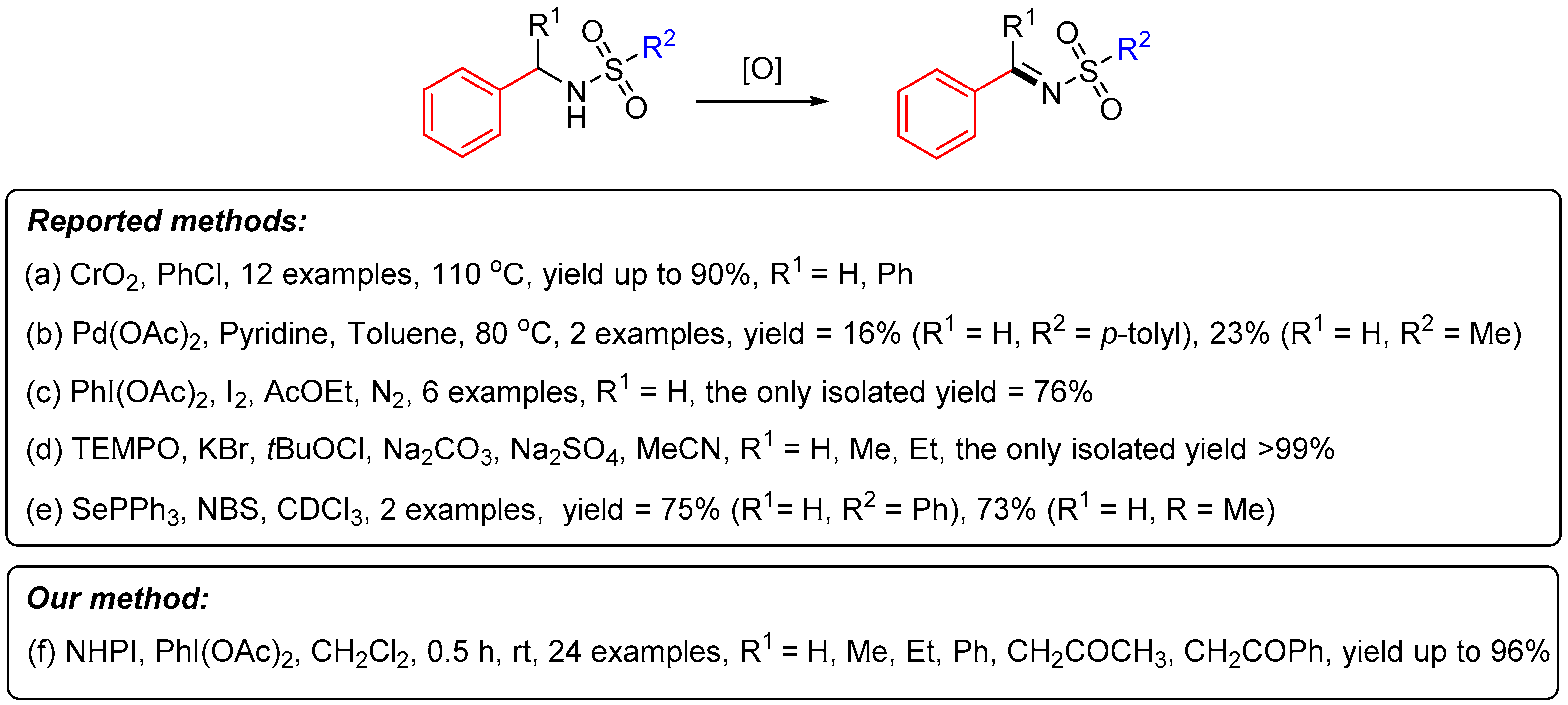
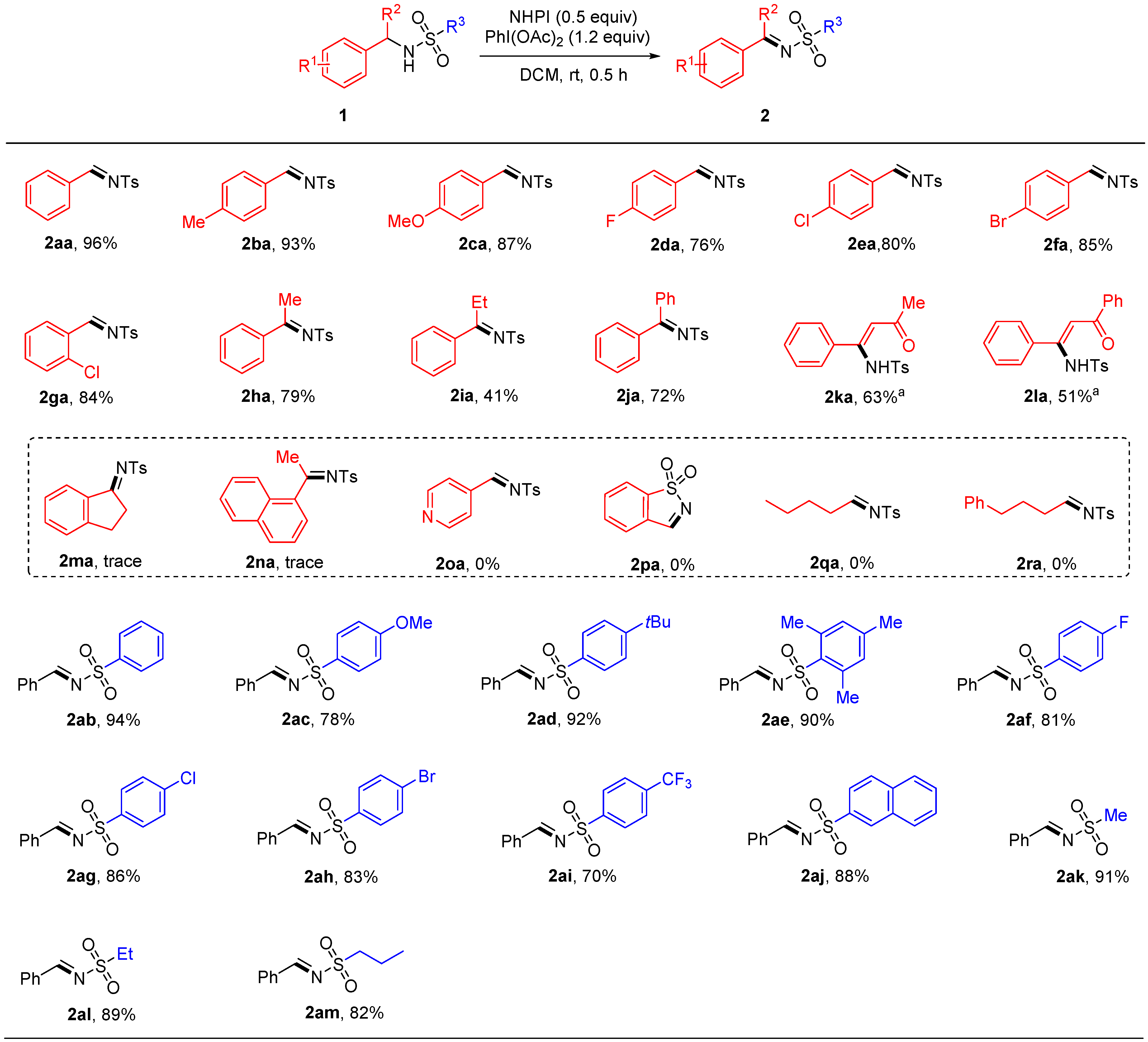
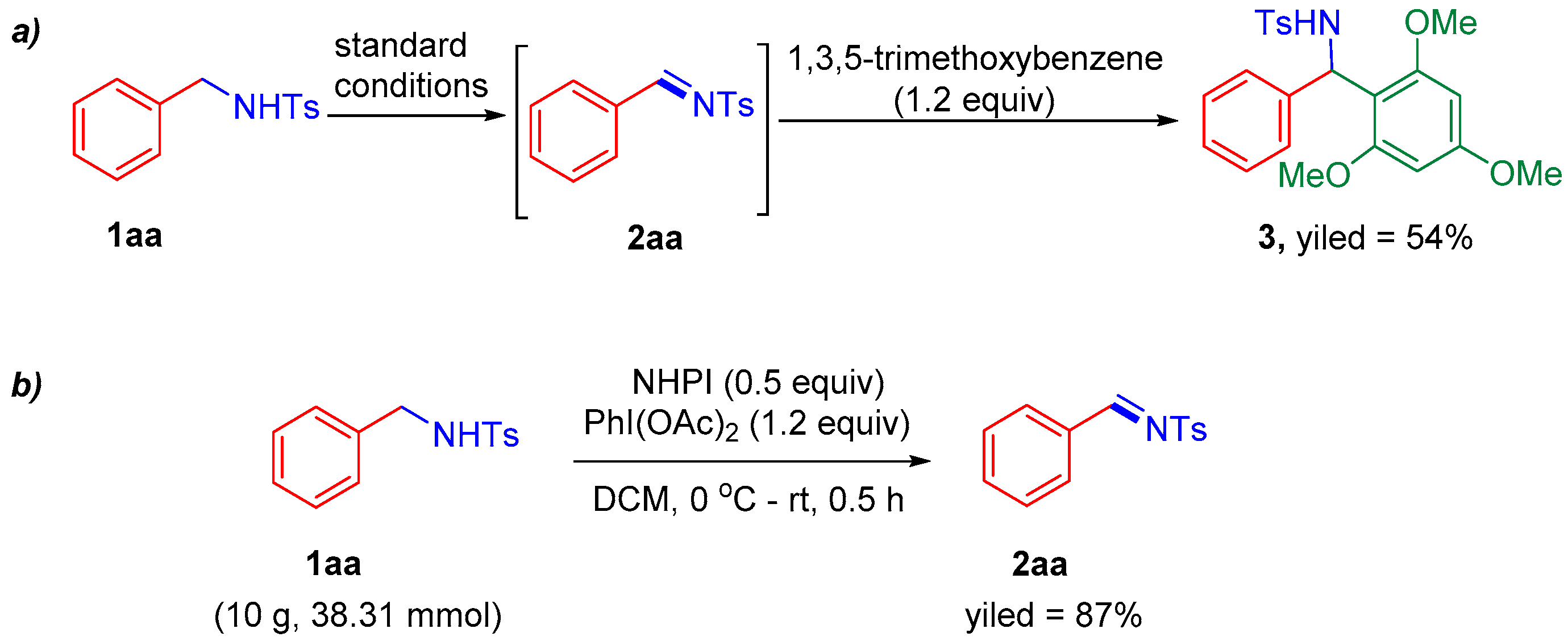
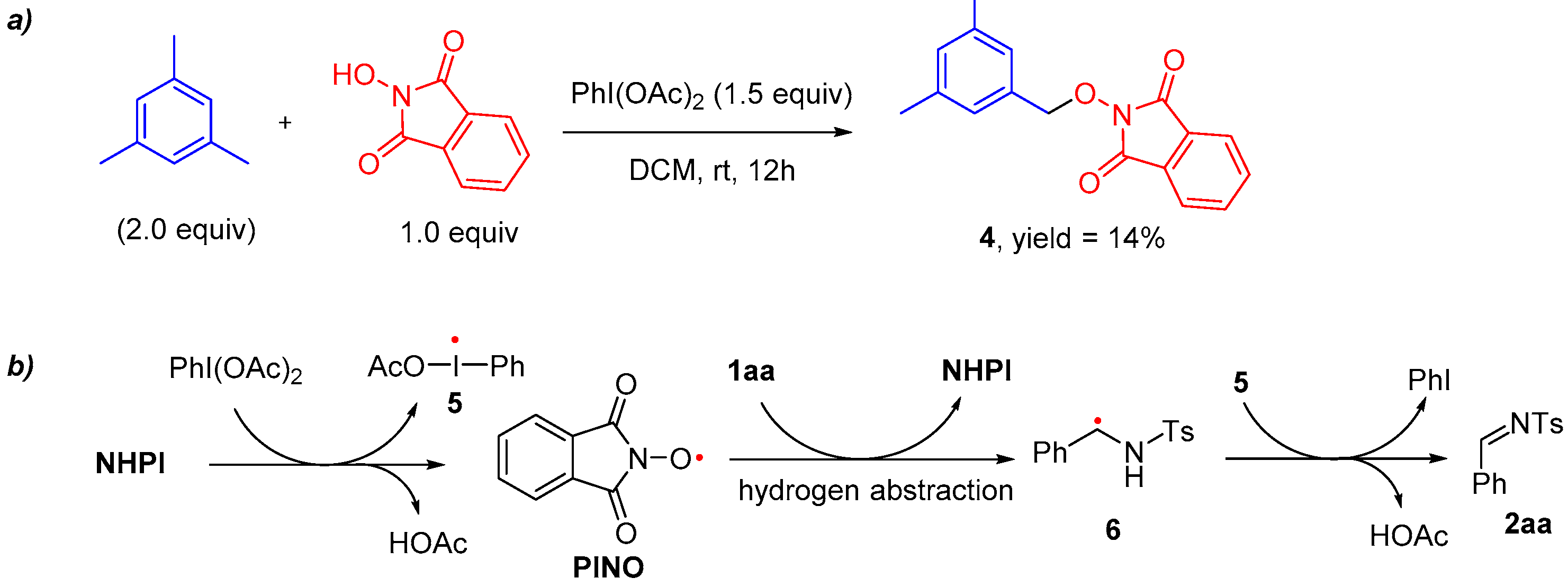
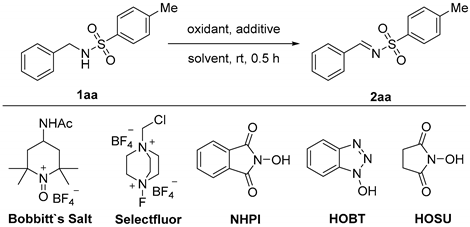
| Entry | Oxidant (equiv) | Additive (equiv) | Solvent (mL) | Yield (%) b |
|---|---|---|---|---|
| 1 | Bobbitt’s Salt (2.0) | - | CH3CN (2) | 32 |
| 2 | PhI(OAc)2 (2.0) | TEMPO (2.0) | CH3CN (2) | 30 |
| 3 | Selectfluor (2.0) | TEMPO (2.0) | CH3CN (2) | 79 |
| 4 | PhI(OAc)2 (1.2) | NHPI (0.5) | CH3CN (1) | 93 |
| 5 | PhI(OAc)2 (1.2) | NHPI (0.2) | CH3CN (1) | 34 |
| 6 | PhI(OAc)2 (1.2) | NHPI (0.5) | DCM (1) | 96 |
| 7 | PhI(OAc)2 (1.2) | NHPI (0.5) | EtOAc (1) | 81 |
| 8 | PhI(OAc)2 (1.2) | NHPI (0.5) | THF (1) | trace |
| 9 | TCCA (1.2) | NHPI (0.5) | DCM (1) | 42 |
| 10 | NBS (1.2) | NHPI (0.5) | DCM (1) | 37 |
| 11 | NCS (1.2) | NHPI (0.5) | DCM (1) | trace |
| 12 | MCPBA (1.2) | NHPI (0.5) | DCM (1) | 0 |
| 13 | BPO (1.2) | NHPI (0.5) | DCM (1) | 0 |
| 14 | K2S2O8 (1.2) | NHPI (0.5) | DCM (1) | 0 |
| 15 | TBHP (1.2) | NHPI (0.5) | DCM (1) | 0 |
| 16 | PhI(OAc)2 (1.2) | - | DCM (1) | 0 |
| 17 | - | NHPI (0.5) | DCM (1) | 0 |
| 18 | PhI(OAc)2 (1.2) | HOBT (0.5) | DCM (1) | 54 |
| 19 | PhI(OAc)2 (1.2) | HOSU (0.5) | DCM (1) | 85 |
© 2019 by the authors. Licensee MDPI, Basel, Switzerland. This article is an open access article distributed under the terms and conditions of the Creative Commons Attribution (CC BY) license (http://creativecommons.org/licenses/by/4.0/).
Share and Cite
Wang, J.; Yi, W.-J. Practical N-Hydroxyphthalimide-Mediated Oxidation of Sulfonamides to N-Sulfonylimines. Molecules 2019, 24, 3771. https://doi.org/10.3390/molecules24203771
Wang J, Yi W-J. Practical N-Hydroxyphthalimide-Mediated Oxidation of Sulfonamides to N-Sulfonylimines. Molecules. 2019; 24(20):3771. https://doi.org/10.3390/molecules24203771
Chicago/Turabian StyleWang, Jian, and Wen-Jing Yi. 2019. "Practical N-Hydroxyphthalimide-Mediated Oxidation of Sulfonamides to N-Sulfonylimines" Molecules 24, no. 20: 3771. https://doi.org/10.3390/molecules24203771
APA StyleWang, J., & Yi, W.-J. (2019). Practical N-Hydroxyphthalimide-Mediated Oxidation of Sulfonamides to N-Sulfonylimines. Molecules, 24(20), 3771. https://doi.org/10.3390/molecules24203771





